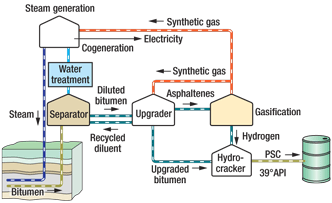What's new in production
Closing the loop on energy and waste in heavy oil production
Closing the loop on energy and waste in heavy oil production One of the major challenges to developing the 174 billion barrels of oil sands claimed as “established reserves” by the Canadian province of Alberta is supplying the large quantities of natural gas needed to produce the oil sands and upgrade them to synthetic crude oil. In 2006, the oil sands industry in Alberta consumed about 1 Bcfd of natural gas, accounting for more than 40% of total gas demand for the province. As oil sands operations shift from the surface-minable resource to the more plentiful deep deposits, which require gas- and water-intensive in situ production methods such as Steam-Assisted Gravity Drainage (SAGD), that gas consumption will only increase. Oil sands development also has much greater operating costs than conventional crude production, natural gas being one of them. If natural gas prices rebound from their current lows, that investment could be jeopardized by higher costs. Regulation of greenhouse gas emissions in Canada or in the US, the carbon-intensive oil sands’ biggest consumer, could have the same effect—and such regulation seems increasingly likely as world leaders prepare for next month’s Copenhagen Climate Conference. This is just what Nexen and Opti Canada are doing at their Long Lake oil sands development project in the Athabasca region of northeastern Alberta. The partners have developed a process that uses gasification to recycle the asphaltene byproduct of Opti’s bitumen upgrading method for use in the both the upgrading step and for steam generation in SAGD. This creates a nearly closed-loop production system that requires far less natural gas than most oil sands operations. The proprietary upgrading technology, called OrCrude, removes the heaviest, lowest-value components of the produced bitumen for gasification, and upgrades the rest, see figure. Because of the gasification step, the entire production and upgrading process uses about 0.5 Mcf of natural gas to produce a barrel of synthetic crude. Compare that with an average 1.9 Mcf/bbl consumed by traditional SAGD and upgrading, according to the Canadian Energy Research Institute. After secondary upgrading in a hydrocracker using hydrogen recovered from the synthetic gas, the output is light, sweet 39°API synthetic crude, more comparable to conventional oil than to typical oil sands products, according to Nexen representative Tim Chatten. The first phase of production began in early 2008, and, after a slow startup due to water treatment issues, “We’ve had production in the range of 10,000 to 12,000 bpd and growing, and we expect to see that grow through the rest of this year,” Chatten said. “Our target is 60,000 bbl of synthetic crude per day, from 72,000 bbl of bitumen.” That would be a much greater yield than is typical in bitumen upgrading. By consuming less gas and producing more and lighter crude, Chatten says Long Lake is expected to generate a C$10/bbl operating cost advantage over competitors; it is also lowering its carbon footprint—a big deal for a play that has been singled out by environmental activists. Another production loop that is being closed—at Long Lake and other oil sands operations—relates to water use. Because of the massive amount of water used to generate steam for SAGD, recycling the water produced along with the bitumen is becoming an increasingly popular way to minimize the operations’ impact on local groundwater supplies. At Long Lake, the use of hot lime softening for desalination, along with other treatment processes to remove solids and oil, allows the operators to recycle 90–95% of the water used, Chatten said. Further plans exist for reducing not only oil sands inputs, but also outputs—i.e., waste. In a way, this is already being done at Long Lake, since the main byproduct of primary upgrading is recyclable asphaltene. But the oil sands waste stream that is proving most difficult to manage is the metal solids, such as lead, mercury, arsenic, nickel, vanadium, chromium and selenium, that are removed in upgrading and discarded, along with wastewater and other solids, in large tailings ponds. According to one report, these tailings ponds cover more than 130 sq km in northern Alberta, and they are a focal point for critics of oil sands development because of their potential risk to local freshwater supplies. A 2006 paper by Opti and Siemens authors discusses the use of a “wet air oxidation process, supplied by Siemens Water Technologies, to process the soot into more valuable forms by destruction of residual carbon, reduction in moisture content, and further concentration of the valuable and recoverable metals.” Benchmark testing of the process found that carbon destruction rates as high as 98% could be achieved under commercially reasonable operating conditions. If implemented, this process would not only greatly reduce a dangerous waste stream, but would produce revenue from the sale of the metals extracted. It may not be possible to make oil sands development a truly closed-loop process. For example, some volume of concentrated brine will always require disposal after any water treatment process, and the global sulfur market cannot possible absorb the mountains of sulfur extracted from oil sands. But every step toward that elusive goal tips the economic and ecological scales a little more in favor of developing this plentiful but challenging resource.
|
|||||||||||
- What's new in production (February 2024)
- Prices and governmental policies combine to stymie Canadian upstream growth (February 2024)
- U.S. operators reduce activity as crude prices plunge (February 2024)
- U.S. producing gas wells increase despite low prices (February 2024)
- U.S. drilling: More of the same expected (February 2024)
- U.S. oil and natural gas production hits record highs (February 2024)




